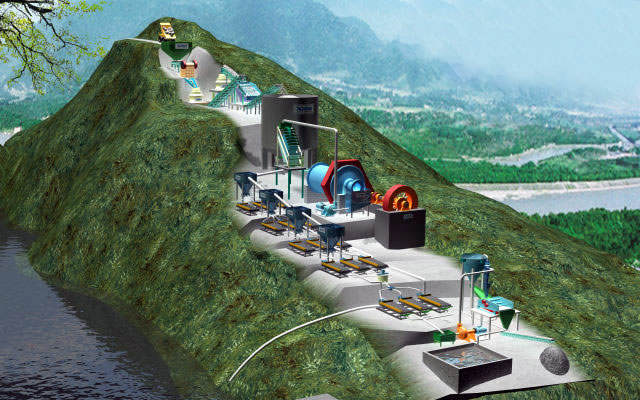|
|
Do you know the beneficiation methods for these 5 types of refractory iron ores?Iron is an important mineral resource for the sustainable development of China's national economy, and China's iron ore resources are mainly "poor", "fine", and "miscellaneous". Therefore, iron resources are not sufficient to meet the needs of national economic development. It is urgent to rely on complex and difficult to select iron ore to increase storage and efficiency, and ensure the sustainable and stable development of the steel industry. Let's take a look at what are the difficult to select iron ores? How to choose? At present, the difficult to select iron ores in China include siderite, limonite, oolitic hematite, composite iron ore, and high sulfur and phosphorus iron ore.
1. Mineral processing methods for difficult to select siderite The grade (theoretical grade) of siderite is relatively low, only 48.02%, and it often coexists with calcium, magnesium, and manganese in a homogeneous manner. The available beneficiation methods for this type of iron ore include gravity separation, high intensity magnetic separation, flotation, roasting, and combined beneficiation. However, if physical beneficiation methods (gravity separation, strong magnetic separation, flotation) are used, it is difficult for the iron concentrate grade to reach over 45%. If the roasting method is used, the iron concentrate grade can be greatly improved, but some useful minerals will be lost during the roasting process. However, the combined beneficiation method needs to choose different combined processes for different types of siderite. Coarse and single particle size disseminated siderite: suitable for jigging or heavy medium beneficiation, high intensity magnetic separation, roasting magnetic separation, and combined beneficiation processes; Siderite with fine particle size embedded: generally suitable for roasting magnetic separation, high intensity magnetic separation, flotation, or magnetic flotation combined beneficiation processes; Multi associated siderite ore (magnetite siderite or magnetite hematite, limonite, and specularite): Generally, a series process of weak magnetic separation and roasting magnetic separation, gravity separation, strong magnetic separation, and magnetic levitation is adopted. 2. Beneficiation method for difficult to select limonite Limonite is rich in crystalline water, and its iron content is not fixed, with a higher grade than siderite (48%~62.9%). Additionally, due to its high tendency to mud during crushing and grinding, it is difficult to obtain a high metal recovery rate. In terms of mineral processing methods, roasting, strong magnetic separation, gravity separation, flotation, and their combined mineral processing methods are commonly used. The roasting method is similar to the mineral processing of siderite, and the grade of the iron concentrate increases during roasting, but the loss is significant; However, single methods such as gravity separation, magnetic separation, and flotation are difficult to obtain iron concentrates that exceed 60%; For the combined beneficiation method, there are gravity separation strong magnetic separation method, flocculation strong magnetic separation method, and original magnetization roasting weak magnetic separation method. The specific process can be selected based on the ore properties. Brown iron ore with single particle size embedded in coarse particles: suitable for gravity separation - high intensity magnetic separation method, with coarse particles using gravity separation and fine particles and slime using high intensity magnetic separation; Low grade, fine-grained disseminated limonite: suitable for flocculation strong magnetic separation method or original magnetization roasting weak magnetic separation method. 3. Beneficiation method for oolitic hematite Oolitic hematite is embedded with extremely fine particle size and often coexists or encloses with siderite, oolitic chlorite, and phosphorus containing minerals, making it very difficult to separate. Conventional single beneficiation methods and combined methods cannot effectively recover -10 μ Fine grained iron minerals of m. If you want to improve the iron concentrate, you need to first conduct ultrafine grinding. The beneficiation method can use a combination of ultrafine grinding, selective flocculation (agglomeration), strong magnetic separation or flotation, reduction roasting, ultrafine grinding, selective flocculation (agglomeration), weak magnetic separation or flotation to improve the iron concentrate recovery rate, but the ultrafine grinding process is more difficult. 4. Mineral processing method for composite iron ore Most of China's iron ore contains two or more types of iron minerals, and the more types, the worse the selectivity. When weakly magnetic iron ores such as hematite, specularite, goethite, siderite, and limonite coexist in this type of iron ore, conventional beneficiation methods can be used to separate this type of iron ore. However, when there is a large amount of siderite and limonite in the mineral, conventional beneficiation methods cannot guarantee its concentrate grade and recovery rate. Therefore, joint processes such as weak magnetic strong magnetic flotation process, magnetization roasting reverse flotation, etc. need to be used to recover iron concentrate. When iron ore coexists with minerals such as fluorite, carbonate, and silicate, the weak magnetic strong magnetic reverse flotation method is often used. 5. Mineral processing methods for high sulfur and phosphorus iron ores Most of China's iron ore contains harmful impurities such as sulfur and phosphorus, especially iron ore rich in pyrrhotite, fine-grained apatite, or collophane, which is more difficult to beneficiate. The commonly used high sulfur and phosphorus iron ore beneficiation methods mainly consist of a combined process consisting of flotation and roasting. High sulfur iron ore: multiple combined processes such as magnetic separation, reverse flotation, selective flocculation, acid leaching, chlorination roasting and acid leaching are used; High phosphorus iron ore: multiple combined processes such as flotation, selective flocculation, and roasting are used. The above are five common types of refractory iron ore and common beneficiation methods (beneficiation processes). Although these types of iron ore are all difficult to beneficiate, selecting suitable beneficiation process methods and equipment has considerable comprehensive recovery value. Therefore, the editor suggests conducting beneficiation experiments on difficult to select iron ores first, and through experimental analysis, customizing suitable beneficiation process plans and supporting beneficiation equipment to achieve ideal investment returns. |




